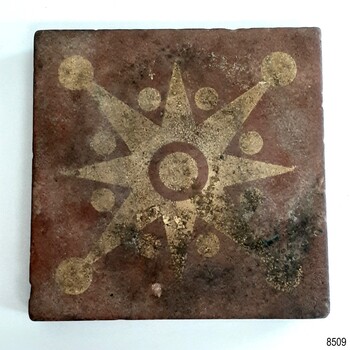Historical information
The floor tile is one of a group of artefacts in the McCulloch Collection that were recovered from the shipwreck Victoria Tower and were donated together. The tile could have been from the ship's cargo or amongst a ship’s fittings. The inscription on the tile is for Maw & Co makers of earthenware encaustic and geometric floor tiles since 1850, when George Maw and his brother Arthur began their first factory in Worcester. In 1862 the company moved to Broseley, Shropshire.
The object is now one of the shipwreck artefacts in Flagstaff Hill’s Mc Culloch Collection, which includes items recovered from the wrecks of the Victoria Tower (wrecked in 1869) and Loch Ard (wrecked in 1878). They were salvaged by a diver in the early 1970s from the southwest coast of Victoria. Advanced marine technology had enabled divers to explore the depths of the ocean and gather its treasures before protective legislation was introduced by the Government. The artefacts were donated to Queensland’s Department of Environment and Heritage Protection (EHP) by a passionate shipwreck lover and their locations were verified by Bruce McCulloch. In 2017 the Department repatriated them to Flagstaff Hill where they joined our vast collection of artefacts from Victoria’s Shipwreck Coast.
The Victoria Tower: -
The three-masted iron clipper ship was built in 1869 in Liverpool, England, as a passenger and cargo ship for the Australian trade. She was named after one of the two towers of the British Houses of Parliament and owned by the White Star line. The Victoria Tower sailed under the command of Captain Kerr from Liverpool towards Melbourne on her maiden voyage. She carried 34 passengers and 16 crew plus a general cargo including bottled beer, slates, iron pipes and hardware. She was almost at her destination when she was wrecked on 17th October 1869 at Point Impossible, west of Thompsons Creek, Breamlea. The shipwreck is a very popular diving site.
The artefact has now been repatriated to Victoria and is located at Flagstaff Hill Maritime Village.
Significance
The artefact is an example of cargo or personal items on board a ship in 1869. It provides a reference point for classifying and dating similar items.
The artefact is significant for its association with the clipper ship Victoria Tower, which is listed on the Victorian Heritage Register as S698.
The Victoria Tower is recorded as the most intact historic shipwreck accessible between Point Lonsdale and Cape Otway.
The Victoria Tower is one of only seven shipwrecks in Victoria that have had more than 100 objects recovered from them reported as a result of the Commonwealth Amnesty held in 1993-94.
Physical description
Ceramic tile, square, with star or compass design.Brown tile has cream design of i-pointed star with a circle in the centre and between, and on the end of, each point. The side profile of the tile shows the division between the top layer and the base, with a groove between the two. The tile was made by MAW & Co. of Broseley, England.
The back of the tile has parallel ridges and is embossed with an inscription. It was recovered from the wrecked ship Victoria Tower.
Inscriptions & markings
Inscribed "MAW & CO BROSELEY"
Subjects
- flagstaff hill,
- warrnambool,
- maritime village,
- maritime museum,
- flagstaff hill maritime museum and village,
- shipwreck coast,
- great ocean road,
- shipwreck artefact,
- wreck dive,
- mcculloch collection,
- bruce mcculloch,
- white star line,
- victorian heritage register,
- clipper ship,
- victoria tower,
- captain kerr,
- shipwreck victoria tower,
- migrant ship 1869,
- cargo ship 1869,
- iron clipper,
- british clipper ship,
- 1869,
- cargo imported to australia,
- tile,
- floor tile,
- ceramic tile,
- compass pattern,
- star pattern,
- flooring
References
- Victoria Tower, VHR S698 Victorian Heritage Database








